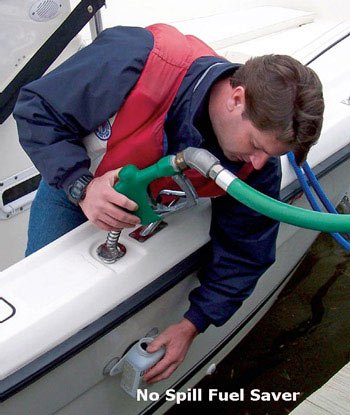
The Proper Way to Fill A Fuel Tank
By Chris Edmonston
At the gas dock or the gas station, here are some tricks to keeping fuel in the tank and out of the water.
There's really only one good way to fill up a portable tank – and that's to place the tank on the ground.
Never leave a portable tank in a boat or in a vehicle, because static electricity builds up from doing simple things such as getting in and out of your vehicle, and the friction causes an electric charge to build up within the gas line as you pump gas. Touching something metallic as you get out of a vehicle and then placing the tank on the ground for fueling is essential for reducing static buildup. It's also recommended that the fuel nozzle touch the can as you're pumping. This allows the static electricity to go through the nozzle, into the can, then into the ground. Because gasoline can expand and contract quite a bit, it's best not to fully fill a gas tank. Remember, the gas you're pumping is almost always coming from an underground storage tank that's probably around 60 degrees. Pumping it into a portable tank that could get up to 100 degrees will make the gas expand by as much as 10 percent. If you fully fill your tank, you could be looking at a sizeable gasoline spill from nothing more than expansion.
I don't know of a single tank "guaranteed" to be spill proof; most older tanks have a built-in vent, and vents are a gas burp waiting to happen. Newer tanks may be ventless, but overpressure can still be vented through the cap. The best way to minimize or prevent spills when backing down a ramp is to go slow and steady.
The main reason you want everyone to get out of the boat when refueling is to reduce the chances of them getting hurt should something go wrong with fueling. Because gasoline vapors are heavier than air, they tend to settle into the lowest parts of the boat. If your boat has an installed blower, it's critical that you use it for the recommended four minutes after fueling. Wind simply won't take away the fumes – only time and your blower will. Make sure you use a marine-rated blower as well. They are ignition protected and designed specifically for removing fuel vapors.
Properly filling a fuel tank can sometimes seem to be a cross between science and voodoo. For instance, our boat has a 105-gallon fuel tank, and a wildly inaccurate fuel gauge; we have a fuel flow meter built into the chart plotter that tells us our fuel consumption. Over the years, we have found that the most accurate tool for knowing when we need to refuel is our logbook of hours on the water. Also, we've recently installed a vent whistle (pictured left) into the fuel line. The whistle is designed to make noise as long as fuel is flowing; as soon as the tank is full, the whistle stops and you know it's full.
This article was published in the September 2010 issue of Trailering Magazine.